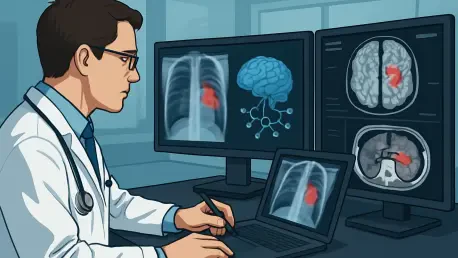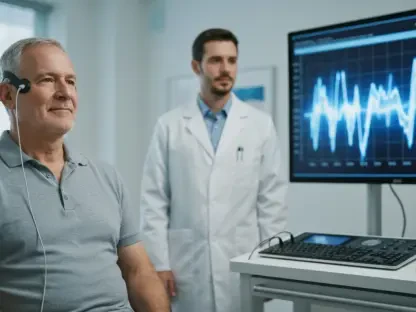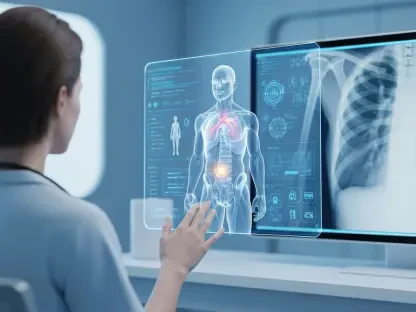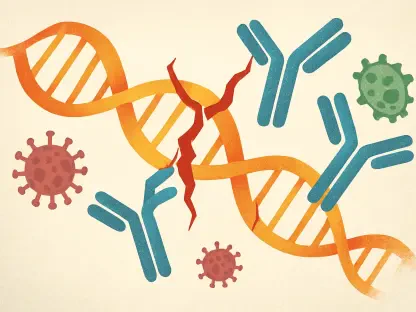In an era where timely medical intervention can mean the difference between life and death, Mayo Clinic has taken a monumental step forward by integrating NVIDIA’s DGX SuperPOD supercomputer, powered by the advanced Blackwell infrastructure, into its healthcare operations. This state-of-the-art artificial intelligence (AI) system is redefining the landscape of diagnostics and patient care by dramatically accelerating the processing of complex medical data. Tasks that once stretched over weeks, such as analyzing intricate pathology slides, are now completed in just one week, offering hope for faster disease detection and treatment. Mayo Clinic’s adoption of this cutting-edge technology underscores a profound commitment to enhancing patient outcomes through innovation. By leveraging unparalleled computational power, the institution is not only streamlining medical processes but also setting a new standard for personalized medicine. This development signals a transformative shift in how healthcare can harness AI to address critical challenges, paving the way for a future where speed and precision are paramount in saving lives.
Revolutionizing Diagnostics with Unmatched Speed
The NVIDIA DGX SuperPOD supercomputer brings an extraordinary level of speed to the realm of medical diagnostics, fundamentally altering how quickly healthcare providers can respond to patient needs. High-resolution medical imaging, often a bottleneck in traditional diagnostic workflows, is processed at unprecedented rates with this technology. What used to be a lengthy ordeal of waiting for results now transforms into a swift operation, enabling doctors to make critical decisions without delay. This rapid turnaround is especially vital in cases where early detection of diseases like cancer can significantly improve survival rates. By cutting down diagnostic timelines from weeks to mere days, Mayo Clinic is ensuring that patients receive timely interventions, a factor that often proves decisive in medical outcomes. The efficiency brought by this AI system is not just a technical achievement but a lifeline for those in urgent need of answers.
Moreover, the impact of this speed extends beyond individual patient care to the broader operational efficiency of healthcare systems. With the supercomputer’s ability to handle vast datasets in record time, Mayo Clinic can manage higher volumes of diagnostic tasks without compromising accuracy. This capability reduces backlog in pathology departments, where delays have historically hindered prompt treatment planning. The ripple effect of such efficiency means that resources are allocated more effectively, allowing medical staff to focus on patient interaction rather than administrative bottlenecks. Additionally, faster diagnostics support clinical trials and research by providing quicker data analysis, accelerating the pace of medical advancements. The integration of this technology marks a pivotal moment where AI becomes an indispensable ally in combating the time-sensitive nature of disease management, setting a benchmark for other institutions to follow in optimizing healthcare delivery.
Tailoring Treatments Through Personalized Medicine
One of the most transformative aspects of the DGX SuperPOD lies in its capacity to drive hyper-personalized medicine, a frontier that reimagines how treatments are designed for patients. By delving into intricate datasets that include genetic and physiological information, the AI models powered by this supercomputer craft treatment plans uniquely suited to each individual. This departure from generic, one-size-fits-all medical approaches heralds a new era of precision medicine, where therapies are fine-tuned to address specific health profiles. Such customization holds the promise of improved outcomes, as treatments can target the root causes of conditions with greater accuracy. For patients with complex diseases, this means a higher likelihood of effective interventions, reducing the trial-and-error often associated with standard care protocols. Mayo Clinic’s use of this technology positions it as a pioneer in delivering care that truly reflects the uniqueness of each patient.
Furthermore, the implications of personalized medicine extend to long-term health management and preventive care, areas where tailored strategies can make a substantial difference. The supercomputer’s analytical prowess enables the identification of risk factors and early warning signs that might be missed by conventional methods. This allows for proactive measures, such as lifestyle adjustments or preemptive treatments, to be implemented before conditions escalate into serious health issues. The ability to predict how a patient might respond to a particular drug or therapy also minimizes adverse reactions, enhancing safety alongside efficacy. As this technology continues to evolve, it could redefine standards of care by embedding personalization into every facet of medical practice. Mayo Clinic’s forward-thinking adoption of AI-driven personalization not only benefits current patients but also lays the groundwork for future innovations that prioritize individual health needs over generalized solutions.
Advancing Medical Research and Drug Development
Innovation in medical research and drug discovery receives a significant boost from the DGX SuperPOD, which excels in identifying patterns within expansive medical datasets. This supercomputer supports the development of foundational AI models that are instrumental in uncovering novel therapeutic approaches and accelerating the creation of new drugs. Pathomics, the intersection of pathology and data science, benefits immensely as AI enhances the analysis of tissue samples to reveal insights previously unattainable. Building on earlier achievements like the Atlas pathology model, Mayo Clinic is pushing the boundaries of digital pathology to refine diagnostic accuracy and treatment efficacy. Such advancements are critical for tackling complex diseases that require innovative solutions beyond traditional pharmaceutical methods. The potential to expedite drug discovery timelines offers hope for addressing urgent global health challenges with cutting-edge science.
Additionally, the supercomputer’s role in research extends to fostering a deeper understanding of disease mechanisms, which is essential for developing targeted therapies. By processing and correlating massive amounts of data from diverse sources, including clinical records and genetic studies, the system helps researchers pinpoint biomarkers that signal disease progression or therapeutic response. This granular insight enables the design of clinical trials that are more focused and efficient, potentially reducing the time and cost associated with bringing new treatments to market. The technology also supports real-time monitoring of research outcomes, allowing for rapid adjustments to study protocols as needed. Mayo Clinic’s integration of this AI capability not only strengthens its position as a leader in medical research but also contributes to a global knowledge base that could benefit healthcare providers and patients worldwide, driving progress in combating some of the most persistent medical conditions.
Building Partnerships for a Scalable Healthcare Future
The collaboration between Mayo Clinic and NVIDIA exemplifies a powerful trend of synergy between healthcare institutions and technology leaders, creating a blueprint for future advancements. This partnership leverages medical expertise alongside cutting-edge computational tools to develop AI solutions that address both current and emerging challenges in healthcare. The DGX SuperPOD’s scalable design ensures that it can adapt to increasing data volumes and evolving medical needs, keeping Mayo Clinic at the forefront of innovation. Such flexibility is vital in a field where the complexity and quantity of information continue to grow exponentially. By aligning with tech giants, healthcare providers can access resources and expertise that amplify their capacity to deliver high-quality care. This model of cooperation serves as an inspiration for other organizations aiming to integrate advanced technology into their operations.
Equally important is the potential for these scalable solutions to influence healthcare on a global scale, extending the benefits of AI beyond a single institution. The adaptability of the supercomputer means that the models and methodologies developed at Mayo Clinic could be customized for diverse healthcare environments, from large urban hospitals to resource-limited settings. This opens the door to widespread adoption of precision diagnostics and personalized treatments, potentially leveling disparities in medical access. The partnership also highlights the importance of continuous collaboration to refine AI applications as new scientific discoveries emerge. By investing in scalable infrastructure, Mayo Clinic is not only preparing for future demands but also contributing to a broader movement where technology and healthcare converge to solve pressing issues. This forward-looking approach ensures that advancements in AI remain relevant and impactful as the landscape of medicine evolves.
Reflecting on a Milestone in Medical Technology
Looking back, Mayo Clinic’s integration of NVIDIA’s DGX SuperPOD marked a defining moment in the application of AI to healthcare, setting a precedent for how technology could transform patient care. The dramatic reduction in diagnostic times provided a critical advantage in treating time-sensitive conditions, while the push toward personalized medicine offered tailored solutions that improved therapeutic outcomes. Innovations in drug discovery and pathomics underscored the institution’s role as a trailblazer in medical research, supported by a scalable infrastructure that adapted to growing demands. The collaboration with NVIDIA exemplified how strategic partnerships could drive progress in the field. Moving forward, the focus should shift to ensuring these advancements reach diverse populations, addressing equity in access to cutting-edge care. Exploring ways to share AI-driven models globally and refining implementation strategies could further amplify the impact of this milestone, ensuring that the benefits of faster, more precise healthcare are realized across varied contexts.









